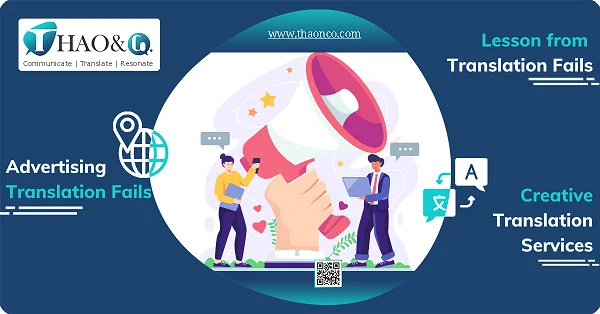The examples of advertising translation fails due to cultural gaps show us the costly consequences of neglecting cultural differences. Want to ensure your international business ventures succeed?
Join Thao & Co. in this article to go beyond language and cultural barriers. We’ll show you how to precisely convey your marketing message to target customers worldwide.
These examples of advertising translation fumbles illustrate how insufficient awareness of cultural norms can lead to misunderstanding, backlash, and even detrimental effects on brand image.
American Airlines faced a wave of confusion (and perhaps amusement) when their “Fly in Leather” campaign took an unexpected turn in Spanish. Their literal translation, “Vuela en Cuero” meant “Fly Naked”, leading to some eyebrow-raising interpretations of the airline’s first-class experience.
This blunder sparked a social media frenzy, wreaking havoc on American Airlines’ brand image with a wave of negative comments and unexpected public reactions.
Pepsi’s bumpy entrance into the Chinese market serves as a cautionary tale, highlighting the critical role of precise translation and deep cultural understanding when building brands abroad. Pepsi’s youthful slogan, “Come alive with Pepsi”, intended to energize young people, morphed into a bizarre promise in Chinese: “Pepsi will bring your ancestors back from the grave”.
The translation fails in advertising due to localization errors, resulting in a message that utterly deviated from Pepsi’s intended youthful appeal. The mistranslation arose due to localization errors, resulting in a message that utterly deviated from Pepsi’s intended youthful appeal.
Clairol’s “Mist Stick” curling iron landed them in hot water in the German market. Things got a little messy in Germany, where ‘mist’ translates not to steamy waves but, well, manure.
The “Mist Stick” campaign went from hair-curling to manure-spreading, leaving German consumers bewildered and reasonably grossed out. This indicates that collaboration with translators possessing linguistic expertise and local cultural sensitivity is of paramount importance to avoid misunderstandings and detrimental effects on the brand image when launching your products and services internationally.
The “Got Milk?” advertising campaign of the American Dairy Products Association (USDEC) is a relevant instance of advertising translation blunder because of cross-cultural differences. In this example, the translation into Spanish conveyed a message completely different from the original one.
Initially, the slogan “Got Milk?” in English simply meant “Do you have milk?” or “Have you got any milk yet?” and aimed to encourage consumers’ consumption of milk. However, when translated into Spanish, it came out as “Are You Lactating?”, essentially asking consumers: “Are you secreting milk?”
This translation blunder completely derailed the advertising campaign from its original intent. Instead of encouraging consumers to drink milk, it left the audience bewildered and awkward while watching the advertising.
McDonald’s
McDonald’s is another example of creative translation done wrong. In the company’s attempt to enter the French market, McDonald’s translated its iconic Big Mac Burger into “Gross Mec” (big guy) to draw attention to the gigantic size of the burger.
However, McDonald’s failed to account for the fact that this word is also used by the French as slang to refer to pimps, people involved in prostitution brokerage. The name “Gross Mec” became a laughingstock across social media, leading to backlashes before the company even set foot in France. Recognizing their mistake, McDonald’s quickly changed the translation into “le Big Mac”.
McDonald’s blunder has helped underscore the importance of localization and localization testing, especially in transcreation projects.

The examples of advertising translation fails teach us important lessons to guarantee our success in advertising and entering international markets.
Before introducing a new product into a new market, thorough research should be implemented to make sure that the name does not carry sensitive or misleading connotations in the target language. If necessary, the product name can be adapted to accommodate market-specific cultural differences and language peculiarities.
Before launching a product or service in a new market, it is recommended to conduct surveys and market research, especially for the brand’s signature advertising, to mitigate risks that translation fails in advertising and ensure that advertising messages will be properly understood and relevant to consumers.
When expanding internationally, it is vital to engage translators with extensive linguistic and cultural expertise. They can help ensure that the advertising message is most accurately and beautifully worded in the target language and culture.
After the advertisement is launched, make sure to monitor and review customer reactions to detect potential problems and promptly address any issues to avoid negative impacts on the brand image.
Read on marketing translation to find more information about this field and be more conscious to not stumble when translating marketing contents.

Amid the international market competitiveness, it is essential to ensure that the message of your brand and product resonates with your target audiences meaningfully and effectively. Thao & Co. understands the need for compelling advertising translations. Our transcreation services are designed to deliver confidence and success for global market expansion projects.
With a pool of talented and passionate linguists, Thao & Co. doesn’t merely translate from one language to another. Our translations are crafted with creativity and flexibility so that your messages can transcend cultural and linguistic boundaries.
We understand that each target market has its own customs, values, and beliefs. Therefore, our translations not only are accurate but also respect the local language and culture. This makes our trancreations unique and fulfills the expectations of customers in every market.
Thao & Co. places a strong emphasis on the use of creative and captivating language. Not only do we provide you with a faithful translation, but also offer creative advice and recommendations to ensure your message can be conveyed in the most appealing and unique way. We believe that the combination of translation accuracy and creativity is the key to making any product or service stand out and achieve success in the international market of diverse languages and cultures.
Thao & Co. provides a Consumer Language Research© service that involves analyzing and evaluating the language that customers typically use in their interactions with products, services, and other brand elements. We explore the way the language affects customers’ purchase intentions, purchase decisions, and general behavior.
We believe that language is crucial in fostering a strong connection and positive interactions with customers. Our Consumer Language Research© service offers you insight into your target consumers – this can be extremely useful for developing effective business strategies.
Let Thao & Co. help you stand out and overcome any language and cultural barriers. We are committed to providing you with innovative, quality, and faithful translations to enable effective communication and meaningful connections with customers around the globe. Contact us today to take the first step on your journey to success!